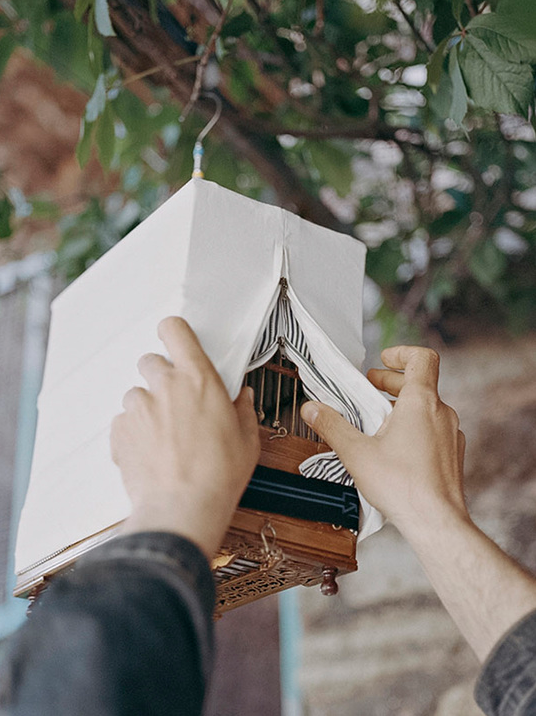Begüm Yamanlar
 |
| Begüm Yamanlar, untitled (1/3), from Zone Series |
 |
| Begüm Yamanlar, untitled (2/3), from Zone Series |
 |
| Begüm Yamanlar, untitled (3/3), from Zone Series |
Begüm Yamanlar, an Istanbul photographer and video artist explores the mystery and uncertainty of space, urban space, rural space and objects in indeterminate space.
Her Zone Series consists of landscapes that simultaneously invite and repel, give the viewer easy entrance tempered by doubt or dread.
Each image includes a path running from the viewer's location into a forest until the path curves out of view or disappears in an unexplained fog. Would I step into the scene? In a dream perhaps; otherwise I move on to the next image. But I always return and contemplate, wondering if I haven't detected a whisper from the image.
The artist clearly has a catalog of tree trunks, limbs, foliage and fleeting spots of light. She uses these judiciously in a way that pulls the individual images together through repetition, overlay and variation. The viewer comes to know these passages as visual friends in an environment fraught with dread.
Yamanlar told me that each photograph combines seven or eight images that she then develops through twenty or so layers. The images have a tonal richness despite the prevailing darkness. Looking at the first of the series I enjoyed the thought that layers can be handled in a way that suggests a full brush in a painting.
"Painting" reminds us that these contemporary photographs have precedence in seventeenth-century Dutch landscape painting. In Jan van Goyen and others, especially Jacob van Ruisdael, we find a similar mystery in forests with paths or roads that invite and then disappear.
Another historical link with the Netherlands is deforestation, a process that was well underway in Holland by the seventeenth-century.* Turkey too is cutting itself toward barren land, a theme found in the work of a number of contemporary Turkish photographers. The hills along the Bosphoros, the respitory system of Istanbul, are being denuded at an alarming pace that almost certainly portends an alarming end.
One cannot but wonder if the persistent dread in Yamanlar's forests express the viewer's apprehensions or those of the forests. Or both.
_________________________
Begüm Yamanlar's "ADA/Island" opens at Galeri Zilberman the evening of July 3. İstiklal Cad. Mısır Apartmanı No.163 K.3 D.10, 34433 İstanbul
Her Zone Series consists of landscapes that simultaneously invite and repel, give the viewer easy entrance tempered by doubt or dread.
Each image includes a path running from the viewer's location into a forest until the path curves out of view or disappears in an unexplained fog. Would I step into the scene? In a dream perhaps; otherwise I move on to the next image. But I always return and contemplate, wondering if I haven't detected a whisper from the image.
The artist clearly has a catalog of tree trunks, limbs, foliage and fleeting spots of light. She uses these judiciously in a way that pulls the individual images together through repetition, overlay and variation. The viewer comes to know these passages as visual friends in an environment fraught with dread.
Yamanlar told me that each photograph combines seven or eight images that she then develops through twenty or so layers. The images have a tonal richness despite the prevailing darkness. Looking at the first of the series I enjoyed the thought that layers can be handled in a way that suggests a full brush in a painting.
"Painting" reminds us that these contemporary photographs have precedence in seventeenth-century Dutch landscape painting. In Jan van Goyen and others, especially Jacob van Ruisdael, we find a similar mystery in forests with paths or roads that invite and then disappear.
Another historical link with the Netherlands is deforestation, a process that was well underway in Holland by the seventeenth-century.* Turkey too is cutting itself toward barren land, a theme found in the work of a number of contemporary Turkish photographers. The hills along the Bosphoros, the respitory system of Istanbul, are being denuded at an alarming pace that almost certainly portends an alarming end.
One cannot but wonder if the persistent dread in Yamanlar's forests express the viewer's apprehensions or those of the forests. Or both.
_________________________
Begüm Yamanlar's "ADA/Island" opens at Galeri Zilberman the evening of July 3. İstiklal Cad. Mısır Apartmanı No.163 K.3 D.10, 34433 İstanbul
*Whited, Tamara L., Jens Ivo Engels, Richard C. Hoffmann, Hilde Ibsen, and Wybren Verstegen. Northern Europe: An Environmental History. Edited by Mark R. Stoll. Santa Barbara, Calif: ABC-CLIO, 2005, 80-81.










